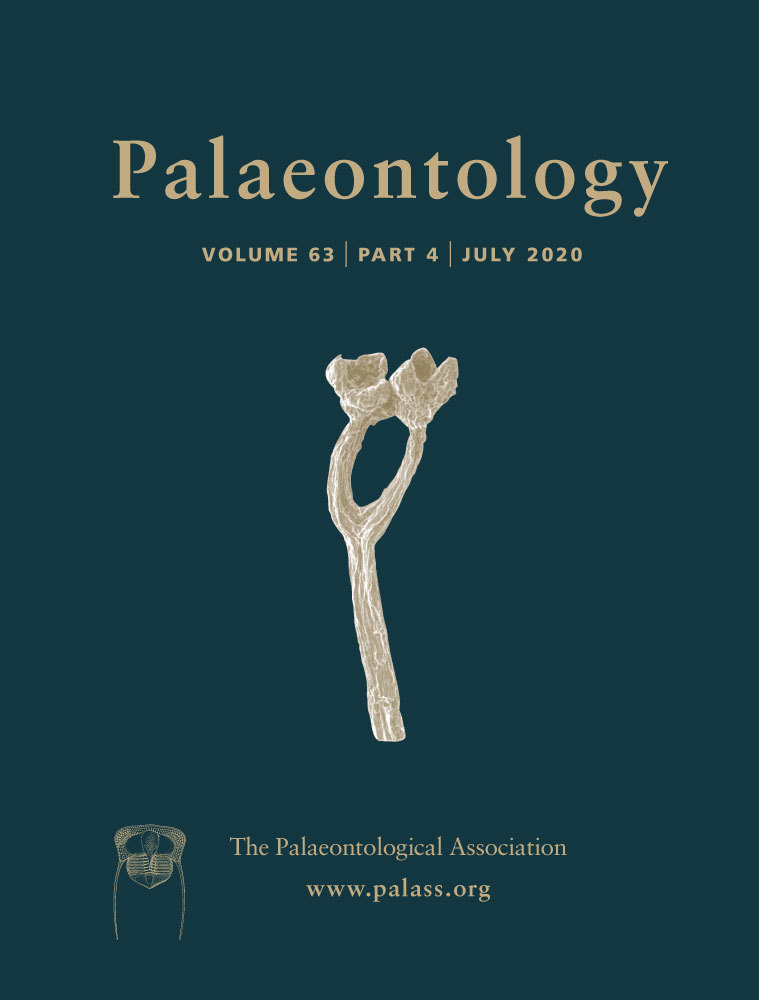Homology of posterior interray plates in crinoids: a review and new perspectives from phylogenetics, the fossil record and development
Abstract
Despite their importance for understanding phylogeny, character evolution and classification, well-constrained homology relationships for posterior plating in crinoids have only recently been attempted. Here, we re-evaluate posterior plate homologies in all major crinoid lineages using development, fossil ontogenies and phylogenetic evidence. Based on these lines of evidence, we change terminology for some posterior plates to correct misnomers and make recommendations for updated terminology of others to better reflect homology. Among pentacrinoids (disparids, hybocrinids, eucladids, flexibles and articulates) the relative position of posterior interray plates, not their topology, reflects homology. From proximal to distal, pentacrinoid posterior plates are the radianal, anal X and right sac plate, regardless of the total number of plates in the adult calyx. Camerate posterior plating contrasts with pentacrinoids, but insufficient data are available to resolve homology relationships between these two clades. More examples of early post-larval ontogeny are needed in camerates and other Palaeozoic crinoids.
The number and arrangement of plates in the posterior interray have been important characters in the taxonomy of Palaeozoic crinoids since the seminal works of Wachsmuth & Springer and Bather in the latter part of the nineteenth century (see Ausich & Kammer (2001) for details). Most Mesozoic to Recent crinoids, and several derived clades of Palaeozoic crinoids, approach perfect pentameral symmetry with a radial circlet of five plates in their adult form. However, the majority of Palaeozoic crinoids have extra or distinctive plating in the posterior or CD interray, which, in some cases, has led to modification of the adjacent rays; and many Palaeozoic crinoids have the radial circlet interrupted by posterior interray plates. Determination of the posterior interray is necessary in order to orient correctly and identify many fossil specimens. In the past, plates in the posterior interray have been collectively termed ‘anal’ plates (a term (pièces anales) introduced by de Koninck & Le Hon (1854, p. 67)) because they are in the posterior region located in the CD interray that is commonly associated with the gut and early developmental position of the periproct (i.e. anus) in extant species. However, this term is a misnomer because many Palaeozoic crinoids have multiple ‘anal’ plates positioned entirely within the calyx between the C and D rays and are not directly associated with (or proximal to) the periproct. Thus, we favour the use of the more accurate descriptive term ‘posterior plates’ for any plates within the CD interray.
In crinoids with a periproct positioned eccentrically on the oral surface or tegmen, the anal opening is commonly shifted toward the posterior interray. A notable exception occurs in the diverse feather star family Comatulidae (Fleming, 1828), in which the mouth is marginal and the periproct is central. Similarly, the anal tube of camerates and a diversity of structures in pentacrinoids, variously called the anal sac, anal papilla or anal cone, are commonly situated in the CD-interray portion of the oral surface. In rare instances, the periproct is located in the side wall of the calyx, for example in representatives of the eucladid superfamily Codiacrinoidea and family Gasterocomidae, in Yunnanocrinus (diplobathrid camerate; Chen & Yao 1993; Webster et al. 2009) and in Pachycephalocrinus (monobathrid camerate; Cole & Toom 2018). In codiacrinoids, the anal opening in mature specimens is either in the CD interray (identified by reference to the distinctive posterior (CD) primary peristomial cover plate) or the C ray (see below). In gasterocomids, there is an additional posterior plate in the CD interray. In Yunnanocrinus and Pachycephalocrinus, the interray in which the periproct is positioned is hypothesized to be the CD interray. The CD interray may also have plating directed toward the periproct or even as far as the base of the anal sac, anal tube, anal papilla, or anal cone.
Regardless of the ubiquity of distinctive CD-interray plating and structures and because of the lack of a fundamental, unifying homology scheme, homologies among these plates have largely been ignored. Ubaghs (1978a) identified four types of posterior plating that correspond with order and subclass-level taxonomic groupings in the crinoid Treatise on Paleontology: (1) disparids; (2) hybocrinids, cladids and flexibles; (3) articulates; and (4) camerates (Fig. 1). He stated that ‘The anal plates may have different origins and it is far from proved that they are homologous’ (Ubaghs 1978a, p. T121). In the literature, the posterior interray plates of the camerates, disparids, cladids and articulates have largely been regarded in isolation even though names for some plates were repeated. Moore & Teichert (1978) adopted a naming scheme that relied largely on topological positions. This is of concern because of the central role these plates have served in the systematics of crinoids; until recently, relatively little progress has been made to clarify crinoid posterior plate nomenclature.
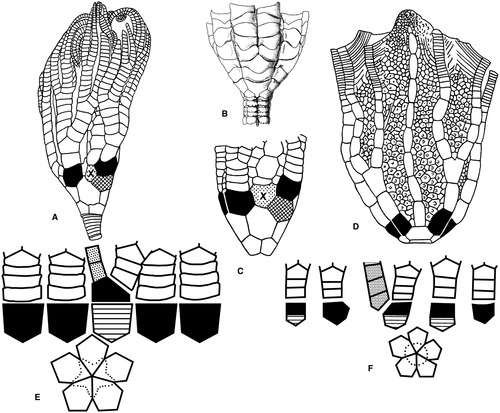
Patterns of plate formation, growth and migration during development are essential for understanding the origins and homologies of plates in the posterior interray. In general, posterior plating of Palaeozoic crinoids has been studied using adult forms. However, in recent years, investigations into post-larval development of fossil crinoids have established patterns of plate formation and growth in the posterior interray, thereby supplying important lines of evidence for interpreting posterior plate homologies (Arendt 1970; Lane & Sevastopulo 1981, 1982a–b, 1985, 1986; Lane et al. 1985; Sevastopulo & Lane 1988). In addition, Wright (2015) used larval development as a guide to reinterpret posterior plate homologies in the parvclass Cladida, as discussed below.
Although patterns of skeletal development are increasingly well understood in extant crinoids, early post-larval stages of growth are known from relatively few Palaeozoic crinoids. Further, examples are spread throughout the Palaeozoic with most examples occurring long after the early Palaeozoic divergence of lineages afforded high taxonomic ranks. Regardless, comparison of early post-larval development provides much needed insight to evaluate homology statements for this critical aspect of crinoid morphology. Based on multiple lines of evidence, three fundamental types of posterior plate configurations are recognized that approximately correspond to the three types of post-larval development identified by Sevastopulo & Lane (1988). These three configurations correspond to the subclass Camerata, parvclass Disparida and parvclass Cladida; the latter group includes the cladids, flexibles, hybocrinids and articulates sensu Moore & Teichert (1978) in the phylogenetic classification of Wright et al. (2017) (Fig. 2). Herein, we summarize previous interpretations of crinoid posterior plates and outline developmental, topological and crystallographic lines of evidence for homologies among the posterior plates of major crinoid groups. Our aim is to develop a more coherent terminology for crinoid posterior plates that reflects current understanding of homology across major clades of crinoids.

Naming posterior plates
Ubaghs (1978a) followed common usage at the time for naming posterior plates. Camerates were considered to have a single interradially positioned proximal plate in the posterior interray, the primanal, a term introduced by Jaekel (1918), that generally has the appearance of first interradial plates in other interrays (Ubaghs 1978a) (Figs 1, 3). The oldest cladids (Moore 1962; Ubaghs 1978a) typically have three most-proximal posterior interray plates: the radianal (named by Bather 1890), anal X (named by Wachsmuth & Springer 1879) and right tube plate (initially referred to as first tube plate by Bather 1890). It is well established that many cladid lineages sensu Wright et al. (2017) iteratively lost one, two or all of these plates in adult individuals, which generated a dilemma regarding what to call plates where only one or two are present in the posterior interray (see Wright 2015). Most disparids have only a single posterior plate that is typically only partially fixed in the aboral cup and rests on the distal shoulders of the C and D simple radial plates or superradial plates. However, Alphacrinus (Guensburg, 2010) was recovered by Ausich et al. (2015a, b) as a sister taxon to all other disparids and has several plates in the posterior interray. In some cases, the posterior plate is not in sutural contact with radial plates (e.g. Iocrinus) (Fig. 1E) or is absent (e.g. Haplocrinites and Pygmaeocrinus). This single disparid posterior plate has been interpreted in the past as the anal X on topological grounds (Moore 1962; Ubaghs 1978a).

A general distinction between camerates and pentacrinoids (non-camerates) is that the primanal in camerates typically appears similar (and in some cases identical) to the proximal interray plate in regular interrays. In contrast, in most other crinoids fixed plating in regular interrays is absent, and CD-interray plating appears to be closely associated with (if not derived from) the C ray. The possibility of a C-ray versus interray affinity of posterior plates among different clades was tested by Bodenbender & Ausich (2000), who examined orientations of crystallographic axes of crinoid plates from all major Ordovician higher taxa recognized at the time. Crystallographic orientations were compared for ray plating versus interray plating in all clades where this comparison could be made (camerates, eucladids and hybocrinids), the posterior plate c-axis orientations were the same as those of other interrays and different from the c-axis orientations of the ray plates. Thus, to be consistent with this result, posterior plating in cladids should be regarded as being independent of the C ray, despite its common topological association. Further, because crystallography of the ray and interray plates is regarded as distinct (Bodenbender & Ausich 2000) and because aboral cup plates are commonly inserted prior to the posterior plating, the homology of the posterior plates should be regarded as quasi-independent from aboral cup plate homologies.
Early post-larval development
The three basic types of posterior plating roughly correspond to the three basic modes of early post-larval development discussed by Sevastopulo & Lane (1988). However, variations are present, and six developmental modes are outlined in Table 1 and discussed below. As noted above, few examples of early post-larval development are known in Palaeozoic crinoids, and all except monobathrid camerates are from Silurian or younger taxa.
| Relative developmental stage | Living crinoids | Eucladids | Disparids without compound radials | Disparids with compound radials | Amphipsalidocrinus | Ordovician camerates (Brower 1975) |
|---|---|---|---|---|---|---|
| Later |
Fixed brachials Fixed interradials (in all rays) Radials Basals |
|||||
|
PPCP Notch for posterior plate Radials with facets Basals |
PPCP Notch for posterior plate Superradials with facets Radials/inferradials with facets Basals |
|||||
|
PPCP Radials with facets Basals |
PPCP Anal opening (with or without plate) Radials with facets Basals Infrabasals |
PPCP Radials with facets Basals |
PPCP Superradials with facets Radials/inferradials with facets Basals |
PPCP Anal opening Radials with facets Basals |
||
|
PPCP Superradials without facets Radials/inferradials without facets Basals |
||||||
|
PPCP Posterior plate Radials without facets Basals |
PPCP Anal opening (with or without plate) Radials without facets Basals Infrabasals |
PPCP Radials without facets Basals |
PPCP Radials/inferradials without facets Basals |
|||
|
PPCP Posterior plate Basals |
PPCP Anal opening (with or without plate) Basals Infrabasals |
PPCP Anal opening Basals |
||||
|
PPCP Basals |
PPCP Basals |
|||||
| Earlier |
PPCP Basals Infrabasals |
PPCP Basals Infrabasals |
- Earliest stage is at the bottom and later stages at the top. Comparable or roughly comparable stages aligned in rows. The two to five entries for each stage are the plates present and presence of anal opening, as appropriate. PPCP, primary peristomial cover plates; note Amphipsalidocrinus is questionably a camerate crinoid.
Extant crinoids
Stages of post-larval development of extant feather stars have been known for more than 150 years (e.g. Thomson 1863; Carpenter 1876; Clark 1915; Mortensen 1920; Springer 1920; Lahaye & Jangoux 1987; Kohtsuka & Nakano 2005; Haig & Rouse 2008); however, development in extant stalked crinoids has only recently been documented (e.g. Nakano et al. 2003; Shibata et al. 2008; Ameniya et al. 2014). In published studies of feather stars and stalked crinoids, the basal plates and primary peristomial cover plates (formerly ‘orals’; see Kammer et al. 2013) are the first plates in the post-larval juvenile (Fig. 4; Table 1). A posterior plate then appears at the midpoint of the C ray and is followed by the radial plates (Mortensen 1920). According to Mortensen (1920) there is no discernible order in the inception of the radial plates, except that the C radial is the last to form, and as it grows it pushes the posterior plate into the CD-interray position. Through ontogeny the single posterior plate of living crinoids is either resorbed or migrates onto the oral surface so no posterior plating is typically incorporated into the CD interray of the aboral cup.
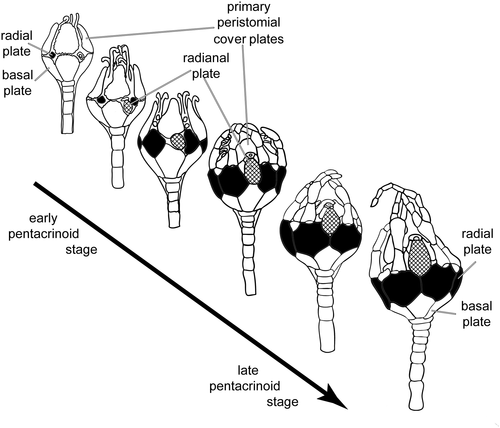
There are rare deviations from this basic model. For example, in crinoids belonging to the Articulata, infrabasal plates are characteristically confined to the earliest post-larval stages, but some evidence suggests that the extant bourgueticrine-grade genus Guillecrinus may possess infrabasal plates in adults (Fig. 5A, B) (cf. Roux 1985; Améziane & Roux 2005). As summarized by Breimer (1978), several crinoids have a ten-plate radial circlet, with the first five regarded as ‘inferradial plates’. In Antedon bifida (Pennant, 1777) these ‘inferradial plates’ are resorbed leaving a five-plate radial circlet. However, all ten plates are retained and bear arms in Promachocrinus and Thaumatocrinus (Breimer 1978; Hess & Messing 2011), with the ten functional arm-bearing plates including five radial plates and five ‘pararadials’. A variant of Thaumatocrinus renovatus Carpenter, 1884a has a ten-plate radial circlet with only the five typical arms, and the CD ‘pararadial’ circlet plate supports a diminutive atomous appendage (Carpenter 1884a; Clark 1915) (Fig. 5C–E). Clark (1915) interpreted this as a six-armed crinoid, but the diminutive appendage is very similar in appearance to the short anitaxis of plates that support the anal sac of several flexible crinoids.
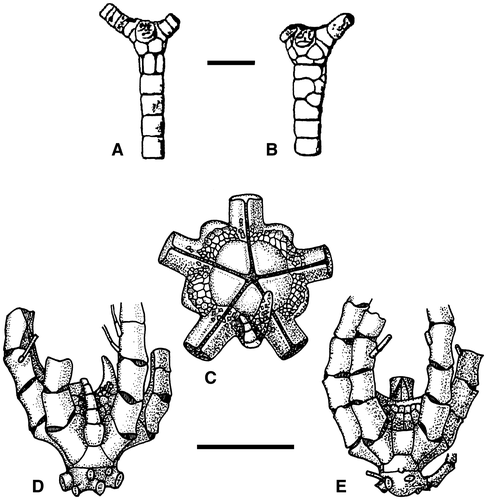
Palaeozoic eucladids
Small, microcrinoid-sized (≤2 mm) aboral cups are relatively rare among eucladids. Eucladids in this size range have plating typically confined to early post-larval circlets, but examples in this size range at a significantly more advanced developmental stage are known (e.g. a juvenile Devonian crinoid described by Ausich & Göncüoğlu in press).
Eucladid early post-larval development is known from a few taxa within the Codiacrinoidea (Koenig & Meyer 1965; Arendt 1970; Sevastopulo & Lane 1988), a superfamily generally agreed to consist mostly of paedomorphic forms, many of which have fewer than five arms or even lack radials in mature specimens. The stratigraphically oldest taxon for which an early post-larval individual is known is the Middle Devonian Streblocrinus brachiatus (Koenig & Meyer, 1965). The unique holotype theca, which is 0.86 mm high, has infrabasals, basals, primary peristomial cover plates and only two radials (with arm articular facets) in the D and A rays. There is a gap, with plates missing, in the C ray below the primary peristomial cover plates; this was interpreted as having been filled by a radial and a radianal plate. Whether S. brachiatus is a juvenile of a five-armed codiacrinoid (as seems likely) or not, it is clear that the CD-interray plate and/or anal opening were formed before all of the radials had developed. The smallest specimens of codiacrinoid taxa that retain one or more radials in maturity, such as Cranocrinus (Arendt, 1970), Dichostreblocrinus (Lane & Sevastopulo, 1982a), Embryocrinus and Monobrachiocrinus (Arendt, 1970), consist of infrabasal, basal and primary peristomial cover plates (Fig. 6) (Table 1). The anal opening developed before the radials, beginning as a small opening at the junction of the BC and CD primary peristomial cover plates and the basals below them. In Cranocrinus and Embryocrinus, which subsequently developed five radials, the anal opening shifted clockwise relative to the primary peristomial cover plates to lie below the midline of the CD primary peristomial cover plate. In mature specimens of Dichostreblocrinus and Monobrachiocrinus, in which a radial subsequently developed only in the D ray, the periproct does not lie in the plane of symmetry defined by the peristomial cover plates. There are obvious parallels with the inception and subsequent development of the posterior plate in Recent comatulid crinoids. In other codiacrinoids such as Bolbocrinus (whose ontogeny is unknown), a plate occurs above the anal opening in the CD interray.
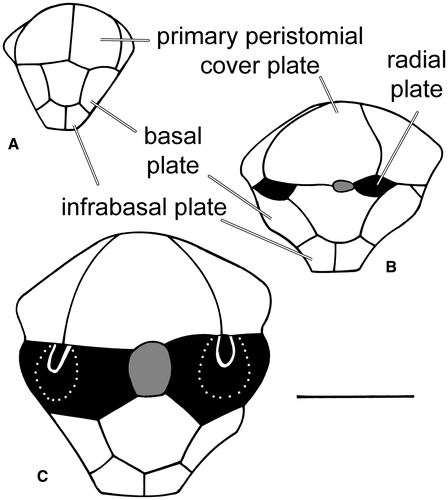
Pentececrinus (Koenig & Niewoehner, 1959), an enigmatic abrachiate microcrinoid from the Late Devonian, has been assigned to the Codiacrinoidea. The unique specimen on which the genus is based consists of infrabasals, basals and primary peristomial cover plates with a small triangular plate at the junction of the BC and CD primary peristomial cover plates and the basals below them. This posterior plate is in the same position as the periproct in codiacrinoids discussed above.
Disparids
The aboral cup of disparid post-larval juveniles must have been more firmly sutured than in other clades, because many disparids are known preserved at this stage of development, either as microcrinoids (e.g. Kallimorphocrinus and Litocrinus and other genera within the late Devonian – Permian family Allagecrinidae) or as juveniles of taxa with larger adults (e.g. Homocrinus, Silurian; Pisocrinus Silurian–Devonian; Haplocrinites Devonian; and Synbathocrinus, Devonian–Permian) (see Lane & Sevastopulo 1982a, b; Sevastopulo & Lane 1988).
Disparids have either five simple radial plates or one to five compound radial plates. In those taxa with simple radials only (e.g. members of the Allagecrinidae and Synbathocrinus), the smallest specimens have a theca consisting of basal plates, radial plates and primary peristomial cover plates (Figs 7-10) (Table 1). As the theca grew, arm articular facets developed on the radials in a set order with that of the A radial invariably last. In those taxa in which a posterior series was present, a notch developed on the left shoulder of the C radial to accommodate its lowest plate, but not before arm articular facets had developed on all five radials.
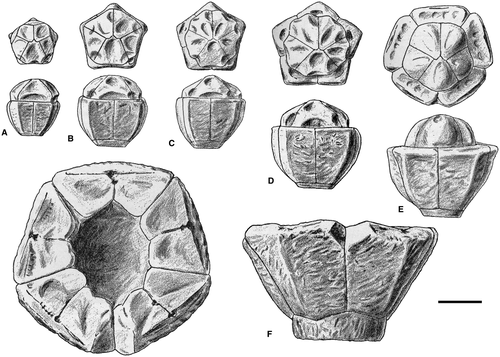
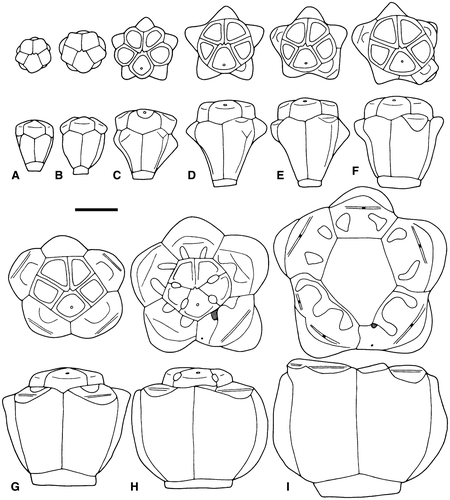
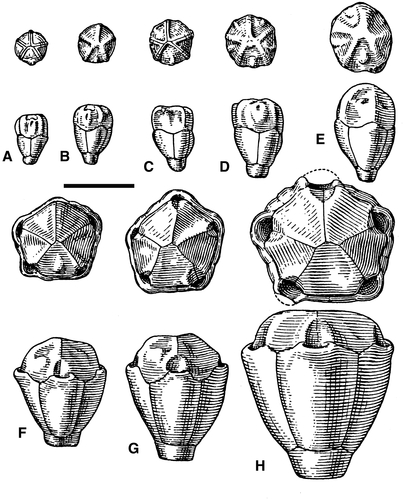
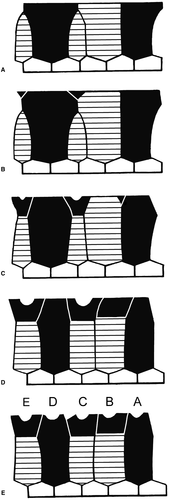
The only disparid with compound radial plates whose ontogeny is well known is Homocrinus, in which the smallest thecae consist of basals, primary peristomial cover plates, C and E ray inferradials and simple B, D and A radials (Sevastopulo & Lane 1988). Superradials were added in the C and E rays at the distal margin of the cup, and arm articular facets developed on them before a small triangular superradial developed in the AB interray. This superradial grew and moved sideways to the B ray position, and arm articular facets developed on it and the D inferradial. (Fig. 10, Table 1). The arm articular facet on the A inferradial was the last to form, but whether it preceded or succeeded the development of the notch on the left shoulder of the C superradial for the reception of the proximal plate of the posterior series is unknown, although given the general pattern in other disparids, it is likely that the former was the case. Sevastopulo & Lane (1988) noted the similarity in development of Pisocrinus to that of Homocrinus, and it appears that Haplocrinites, which lacks a posterior series, shares a similar pattern (GDS unpub. data). The disparid taxa for which the ontogeny is more or less well known, and which exhibit essentially the same pattern of development, are distributed widely among the branches of the cladogram generated by Ausich (2018, fig. 8), which, assuming this pattern of development is not homoplastic, suggests that it was shared by a clade encompassing the majority of disparids. Taxa that lie outside this clade, for which ontogenetic data are lacking, are all Ordovician in age, with the exception of Eomyelodactylus; they include Alphacrinus, Geraocrinus, Anomalocrinus, Tryssocrinus, Pariocrinus, Daedalocrinus and a large clade that includes Iocrinus (Ausich 2018).
Camerates
Compared with evaluating posterior plate homologies between subclades of Pentacrinoidea discussed above, the Camerata present a challenge. As discussed below, examples of early post-larval camerates are controversial because they are either taxa for which their status as a camerate is questioned or have a developmental state very advanced for its size. Thus, early post-larval development in camerates may or may not be directly comparable to disparids and cladids. Additionally, the Camerata has no extant descendants, so direct observation of larval development is not possible.
Despite these caveats, several growth series of undisputed camerate crinoids have been reported in the literature. Brower (1975, 1978) summarized these from previous work by Laudon (1967) and Brower (1973). They include the following taxa, all of which are monobathrid camerates: Alisocrinus tetramatus Brower, 1973 (Ordovician); Eopatelliocrinus scyphogracilis Brower, 1973 (Ordovician); Pycnocrinus dyeri (Meek, 1872) (Ordovician); Macrostylocrinus pristinus Brower, 1973 (Ordovician); Platycrinites s. l. bozemanensis (Miller & Gurley, 1897) (Mississippian); and Xenocrinus multiramus Ramsbottom, 1961 (Ordovician). In addition, Webster et al. (2011) described a microcrinoid-sized specimen of Platycrinites s. l. sp. from the Pennsylvanian of Iran. Excepting Xenocrinus, all of the species for which growth series are known belong to suborder Glyptocrinina (Alisocrinus, Eopatelliocrinus, Glyptocrinus, Macrostylocrinus and Platycrinites s. l.) with the primanal on the distal shoulders of the C and D radial plates. Xenocrinus belongs to suborder Compsocrinina (with the primanal in sutural contact with the CD basal plate directly below). For all of these taxa, a series of specimens has been described from the smallest in the microcrinoid size range to the adult.
In the Ordovician camerates listed above, the smallest specimens have fixed interradial plates and arms and some have fixed interbrachial plates (Brower 1975, 1978) (Figs 13, 14). In each progressively larger growth stage, more interradial and interbrachial plates were added (Figs 13, 14). In many specimens, especially those of the glyptocrinine-type, the orientation of these small crinoids cannot be determined; but in all cases, a single proximal-most interradial plate is centrally located at the base of the interray. This is also true in specimens where the primanal can be identified (Figs 13, 14). All of these crinoids have symmetrical plating in the CD interray with an anitaxis of plates leading distally. None have the primanal preferentially associated with the C radial plate (Strimple & Watkins 1955; Ausich et al. 1998; Gahn 2015; Cole et al. 2017).
Platycrinites s. l. bozemanensis has only part of one fixed interradial plate in an adult. This condition is also present in the smallest early post-larval specimen (Brower 1975, 1978). The minute specimen (0.6 mm high) of Platycrinites s. l. sp. described by Webster et al. (2011) is reported to have arm articular facets developing on the B, C, D and E radials, a plate resting on the shoulders of the C and D radials, and a tegmen consisting of at least 12 plates.
Two fossil microcrinoid growth series have been attributed to camerates (Cyttarocrinus and Amphipsalidocrinus) (Figs 11, 12). In 1965, Koenig described an early post-larval growth series that he attributed to Cyttarocrinus eriensis (Hall 1862). These Cyttarocrinus specimens are from the Devonian Windom Shale Member of the Moscow Formation (Givetian) (Koenig 1965) (Fig. 11). The growth series is identical to that of disparids (see above; Figs 7-9) and Cyttarocrinus specimens of intermediate size (between the largest microcrinoid and a typical adult) are not known. Subsequently, the identification of these early post-larval specimens as Cyttarocrinus has been called into question (Frest & Strimple 1977; Ubaghs 1978b; Lane et al. 1985).
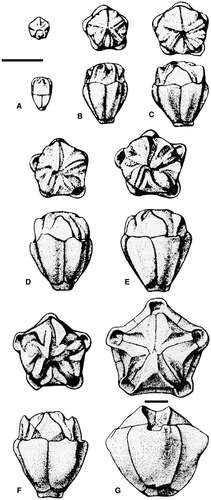
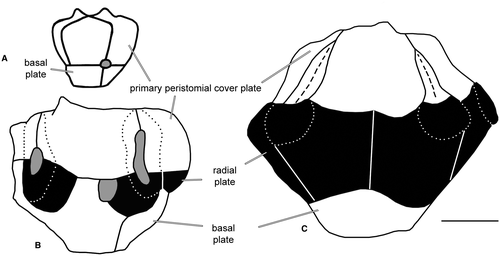
Amphipsalidocrinus is a Silurian–Permian microcrinoid known only from early post-larval growth series (Fig. 12). It is a monocyclic crinoid distinct from any known disparid (Lane et al. 1985). Lane et al. (1985) concluded Amphipsalidocrinus was a paedomorphic monocyclic camerate that became an adult at a very small size (Fig. 12). However, it could also be interpreted as a pseudomonocyclic cladid crinoid.
Interpretation of homologies and implications for terminology
Cladids
As discussed by Wright (2015), there is a long history of discussion on naming posterior plates of cladids and interpreting their homologies (e.g. Wachsmuth & Springer 1879; Carpenter 1882; Bather, 1890, 1891, 1918; Clark 1915; Mortensen 1920; Springer 1920; Kirk 1944; Moore 1952; Ubaghs 1953; Moore 1962; Philip 1964, 1965; Moore & Teichert 1978; Ubaghs 1978a; Webster & Maples 2006; and others). The issue is that topology (position on the aboral cup/calyx of adults) has typically taken precedence over considerations of homology resulting in non-homologous plates having the same name and homologous plates being given different names (Wright 2015). This practice occurs in crinoids and is also pervasive across fossil echinoderm clades more broadly (Sumrall & Waters 2012). These incongruities are unacceptable today when precise homology statements are necessary for making evolutionary interpretations and are required for numerical phylogenetic analyses.
Three proximal-most CD interray plates are common in Ordovician to middle Palaeozoic cladids (Figs 1, 3), whereas a reduced number of plates (2, 1 or 0) is common among post-Mississippian cladids, including living crinoids. In the three-plate condition, these plates are the radianal, anal X and ‘right tube plate’, with the radianal beneath or partially beneath the C radial plate, the anal X in an interradial position typically above and to the left of the radianal plate and the ‘right tube plate’ above or above and to the right of the anal X plate (Fig. 3). Because the anal sac and anal tube are regarded as fundamentally different structures and because cladids have an anal sac (Ausich & Kammer 2010), the ‘right tube plate’ is a misnomer and is corrected herein to the ‘right sac plate’. It is straightforward to infer homology of these plates if all three co-occur, but confusion exists if only one or two plates are present in the aboral cup.
Considering the evidence from phylogenetic systematics, fossils and development of fossil and living crinoids (and consistent with many asides in the literature, e.g. Kirk 1944) Wright (2015) concluded that the relative position rather than the absolute position was a more accurate guide to naming posterior plates in cladids, so as to reflect homologies. This is consistent with crinoid development and with the fact that distal posterior plating may be incorporated onto the oral surface or the anal sac and may not be recognizable as fixed aboral cup plates. It should be emphasized that our focus here is only the number of posterior plates fixed in the aboral cup.
In fossil cladids and extant crinoids, the first posterior plate appears at the same time during development and is considered homologous (Wright 2015) (Table 1). Following Wright (2015), where three posterior plates are present, the proximal plate is the radianal plate, which is followed by the anal X and the right sac plate (Fig. 3B). If two plates are present in the aboral cup, the proximal plate is the radianal followed by the anal X (Fig. 3C), and if only a single plate is present in the aboral cup, this is regarded as the radianal (Fig. 3A). Thus, the sequence of plates informs homology based on development rather than solely on the topology of adult plates. Interested readers are encouraged to see Wright (2015) for additional arguments and discussion of posterior plate homologies and evolution among cladids.
Webster & Maples (2006) proposed an important alternative solution to this cladid posterior plate problem by simply naming posterior plates in order: ‘primanal, secundanal, tertanal’. Although this scheme is consistent in many ways with the results proposed by Wright (2015) and followed here, it ignores established terminology and is problematic for framing primary homology statements needed for phylogenetic analysis and testing alternative patterns of character evolution.
Although the Wright (2015) hypothesis is considered the default interpretation, exceptions undoubtedly exist, including both true exceptions and teratologies. Detailed developmental studies and examination of both the exterior and interior surfaces of aboral cups are necessary to demonstrate exceptions.
In a few genera, two plates occur in the radianal position. These compound radianals occur in some primitive cladid genera, such as Aethocrinus (Ordovician; Ausich 1996, fig. 5.3) and Carabocrinus (Cladida, Ordovician; Lane & Moore 1978, fig. 377.2). However, the occurrence of this pattern of plating may occur also in Ammonicrinus (Flexibilia; Ubaghs 1953, 1978a; Wanner 1954) and indicates that this condition was derived independently more than once. Traditionally, the two parts of a compound radianal are referred to as the inferradianal and superradianal. These terms are maintained here, but the homologies of the inferradianal plate and superradianal plate to the single radianal plate are not clear and will require knowledge of development in crinoids with compound radianals to be confirmed.
Merocrinus (Cladida) has an anomalous posterior series for a cladid (Sevastopulo & Lane 1988; Guensburg 2012). In fact, it is topologically identical to that of the disparid Iocrinus. In Merocrinus, the proximal-most C-ray plate is equivalent in size and shape to other radial plates. Immediately above is an axillary plate approximately the same size with the posterior series articulated with the left shoulder and the C-ray arm articulated to the right shoulder. Moore & Lane (1978a, p. T626) interpreted Merocrinus with a C-ray radial and brachianal, analogous with disparids and unlike other cladids (see discussion below) and the anal X articulated to the left shoulder of the superradial. One of the several alternative interpretations is that the proximal-most C-ray plate is the radianal shifted to a position directly beneath the C radial, which has the anal X articulated to the left shoulder of the C radial. Several workers have proposed that Merocrinus has a pseudodicyclic aboral cup, with column meres inserted beneath the basals (Guensburg 2012). This hypothesis was tested by Ausich et al. (2015a) using phylogenetic analyses. Analyses in which Merocrinus was not included, coded as a disparid, and coded as a eucladid, were compared. The best resolved tree was from the analysis in which Merocrinus was not included. Both types of Merocrinus inclusion yielded more most-parsimonious trees and unexpected topologies. If coded as a disparid, Merocrinus formed a clade within the disparids that contained two eucladids. If coded as an eucladid, all non-camerates and protocrinids are plotted along a polytomy (Ausich et al. 2015a). Another factor relevant to this discussion is that Merocrinus has a holomeric column. Thus, it seems very unlikely to have added column meres to the aboral cup. Merocrinus is a most unusual form that requires further study (see Ausich et al. 2015a).
Disparids
Although a few disparids lack any evidence of posterior plates in the adult (e.g. Quiniocrinus, Zophocrinus and pygmaeocrinids) most disparid crinoids have a single posterior plate that is either partially or entirely incorporated into the aboral cup. Plating in the posterior interray has been debated in part because of the presence of compound radial plates that are common in the C ray and E ray and are also present in other rays in some groups. Numerous studies have addressed disparid posterior plate terminology, including Hall (1866), Meek & Worthen (1873), Wachsmuth & Springer (1880, 1890), Bather (1890, 1893, 1900), Moore & Laudon (1943, 1944), Moore (1948) and Ubaghs (1953, 1978a). Sevastopulo & Lane (1988) outlined the post-larval development of Homocrinus (Silurian) that had superradial plates added as a distinct, incomplete circlet of plates above the inferradial plates (Fig. 10). The single posterior plate was not introduced until all superradials, simple radials and radial facets were in place (Table 1). This posterior plate has typically been named the anal X (Moore 1962; Ubaghs 1978a; Moore & Lane 1978b). Thus, in contrast to cladids, in which the first posterior plate was emplaced prior to the formation of radial plates, disparids have a single posterior plate formed after all radial plates had developed for long enough to have a radial facet (Table 1). Regardless, the adult position of the disparid ‘anal X’ is similar in the vast majority of disparids. Despite both disparids and cladids possessing plates historically called the ‘anal X’, no homology between these plates has previously been identified. The character descriptions for these taxa are based solely on the historical plate names rather than on a shared underlying homology scheme.
Although the insertion of the so-called ‘anal X’ of disparids occurred later during development than the radianal in cladids, this plate is similar in structure and its association with the C-ray plating to that of cladids. Similarly, it is also the first plate to develop that leads to the anal sac. Given the patterns of posterior plate development and evolution observed among lineages of cladids (including extant species; see Wright 2015), the close phylogenetic affinities between disparids and cladids (Guensburg 2012; Ausich et al. 2015a; Wright et al. 2017) and these additional lines of evidence, we regard the ‘anal X’ (sensu Ubaghs 1978a) of disparids to be homologous with the radianal plate of cladids and suggest that it should be called the radianal plate (Fig. 3D). We hypothesize that the emplacement of the radianal plate in disparids was simply delayed relative to cladids. This interpretation results in the same homology statements based on relative position for all members of the parvclass Pentacrinoidea. The most common posterior plate positions in disparids are for the radianal to be articulated to the upper left shoulder of the C superradial (see discussion below) or sutured below to the upper left shoulder of the C radial and the upper right shoulder of the D radial.
In other disparids, the posterior series appears to branch away from the C ray into the CD interray; however, the position from which the posterior series branches varies from the first to the third proximal-most C-ray plate (Ubaghs 1978a). This variability has resulted in various plate names, such as aniradial, anisuperradial, anibrachianal, brachianal and superradianal. Moore (1962) and Ubaghs (1978a) only recognized aniradial and brachianal in disparids. These were differentiated on topology rather than relative sequence, analogous to earlier interpretations of cladids discussed above. On both the aniradial and brachianal, a bifurcation is present with the posterior series toward the left and the C-ray arm toward the right. If this plate is positioned within the aboral cup, it is considered an aniradial (Moore 1952); whereas if it is above the radial circlet, it is considered to be a brachianal (Bather 1890). An anibrachial differs from superradials of other rays only by having two facets distally. A brachianal differs by not being in the aboral cup and by having the proximal facet similar to facets on the radial plates of other radial plates. However, the sequence of plates in the C ray is identical in crinoids with a compound C radial, an aniradial or a brachianal. We suggest that the terms aniradial and brachianal be replaced by C superradial. This interpretation is consistent with Bather (1900, p. 121, 146; non p. 120) and Ubaghs (1953) (see Moore 1962, table 1).
Of course other variations exist. Peniculocrinus has a compound radial plate, and each ray has two fixed brachials and either four or five free brachials. The Peniculocrinus C ray is unique because a thin extension of the C-ray first brachial plate goes beneath the radianal plate, separating it from the C-ray superradianal.
A striking departure from most disparids is the posterior series in Eustenocrinus and Ramseyocrinus, in which the posterior series is directly above the C superradial, replacing the C-ray arm entirely (Moore & Lane 1978b, fig. 347.1a; Donovan 1984; Ausich 2018).
Most aspects of Calceocrinidae morphology are unique, including posterior plates. In four-armed calceocrinids (e.g. Cremacrinus and Paracremacrinus), the posterior series forms a column of plates directly above the C-radial plate (as in Eustenocrinus). In contrast, in three-armed calceocrinids (e.g. Synchirocrinus and Halysiocrinus) a single superradial plate (subanal of Brett 1981) exists rather than both the B and C superradials, and a column of posterior plates is directly above this plate.
Camerates
The posterior plating of camerates has received comparatively less treatment than that of pentacrinoids. Nevertheless, homology determination in camerates is important both for comparisons among camerates and between camerates and pentacrinoids. Notably, the posterior of camerates is distinct from that of pentacrinoids crinoids, making homology determination particularly problematic at deep phylogenetic scales. Ironically, camerates, which typically are the clade with the most robustly sutured adult thecae, have the poorest record of microcrinoid-sized juveniles. This issue complicates homology comparisons between camerates and pentacrinoids.
In camerates, the proximal-most plate in the CD interray is traditionally termed the primanal (Jaekel 1918; sensu Ubaghs 1978a) and may be situated between the C and D radial plates and in contact with the CD basal plate or sutured on the upper shoulders of the C and D radial plates. In contrast to pentacrinoids, plating of the camerate posterior interray closely resembles that of other interrays, and is identical to that of regular interrays in approximately 20% of diplobathrid genera (e.g. Gazacrinus, Nyctocrinus, Gustabilicrinus and several anthemocrinids) and several groups of monobathrids (e.g. clonocrinids, eucalyptocrinitids and many platycrinitids) (Ubaghs 1978b). In instances where the posterior interray differs from the regular interrays, differentiation can be expressed in one or more ways. The primanal may be the only plate interrupting the radial circlet; the primanal may be enlarged relative to regular first interray plates; there may be additional (most commonly three vs two) plates sutured in the row above the primanal compared to those in regular interrays; the posterior interray may have other additional plates; and/or the posterior interray may be wider than the regular interrays, either from an increase in the total number of plates or from an increase in the size of the plates. In some cases, a central column of plates, termed an anitaxis (Figs 3E, 13, 14) is present in the posterior interray, which may or may not be demarcated by a ridge termed the anitaxial ridge. Regardless of the configurations of the camerate posterior interray, key issues for understanding homology of posterior plates are: (1) determining what posterior plate or plates are homologous between camerates and pentacrinoids; and (2) identifying a homologous posterior plate (i.e. primanal) across camerates, especially in instances where posterior morphology deviates from the normal arrangement.
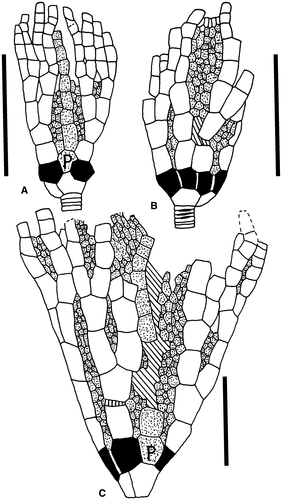
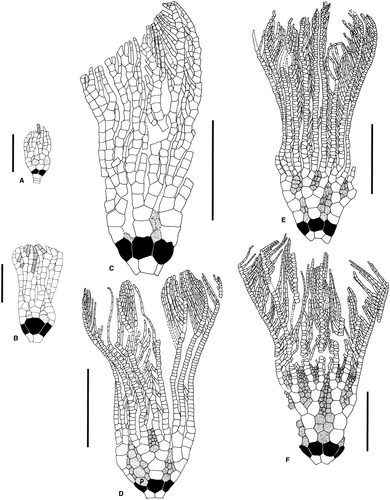
Seven hypotheses for camerate posterior plate homologies were outlined by Ubaghs (1978a, p. T129); only three of which are currently regarded as conventional. These include: (1) a supplemental plate, equivalent to a pararadial plate as discussed above; (2) an interradial plate equivalent to the first interradial of other interrays; and (3) homologous with the radianal plate of larval feather stars (Carpenter 1886; Bather 1900; Wilson 1916; Moore & Laudon 1943; Spreng & Parks 1953; the latter hypothesis from Brower 1973, 1975). After his discussion, Ubaghs (1978a) concluded with ‘[a]t present no evidence allows a satisfactory choice between these possibilities…’ Unfortunately, little new information has become available since 1978.
As noted above, the specimens that definitively establish early post-larval growth in camerates are problematic, and the only definite camerates in the microcrinoid size range are at a much more advanced developmental stage than comparably sized pentacrinoids. In most respects, these are miniatures of adult morphologies with fewer plates (Figs 13, 14). None have the proximal-most CD interradial plate closely associated with the periproct, as is the case in disparid and eucladid microcrinoids. Instead, the anus must have been positioned much higher on the tegmen, especially in Xenocrinus (Fig. 13) and Alisocrinus (Fig. 14) in which an anitaxis begins on the primanal and presumably led to an anus that is much higher and probably on the tegmen. Based on Xenocrinus and Alisocrinus, it seems unlikely that the anal opening of early post-larval camerates was initially associated with the primanal. As a result, it remains unclear which pentacrinoid posterior plates, if any, are homologous to the primanal of camerates.
Within Camerata, identification of a homologous primanal is typically straightforward. In most cases, the adult camerate has a symmetrical posterior comparable to other interrays, and the primanal is easily identifiable as the proximal-most plate in the CD interray. However, posterior interray variations do occur in camerates, such as posterior plating with a large plate that is positioned centrally in the interray with smaller plates surrounding it (e.g. Hercocrinus, Diabolocrinus and Deocrinus). In these cases, the position typically occupied by a single, large, proximal-most plate (the primanal) is instead occupied by two or more small plates. Because the large, central plate probably formed first and smaller accessory plates were then inserted around it, the central plate, rather than the smaller, proximal accessory plates, is considered the primanal.
In a few unusual instances, camerates may have an asymmetric anitaxis that arises from the C-ray primibrachial (Strimple & Watkins 1955; Ausich et al. 1998; Botting 2003, 2018; Gahn 2015; Cole et al. 2017). These cases are restricted to Ordovician diplobathrids (e.g. Ambonacrinus, Cefnocrinus, Pararchaeocrinus, Trichinocrinus) (Fig. 15). The posterior interrays in these crinoids have one or more smaller plates situated in the proximal-most position of the posterior interray. The first plate in the anitaxis, which is offset to the C-ray side and is in sutural contact with the C-radial plate or primibrachial, should be considered the primanal rather than the smaller proximal-most plates, which should be considered accessory plates as in Hercocrinus, Diabolocrinus and Deocrinus. Aspects of these unusual camerate plating patterns mimic plate arrangements in some pentacrinoids.
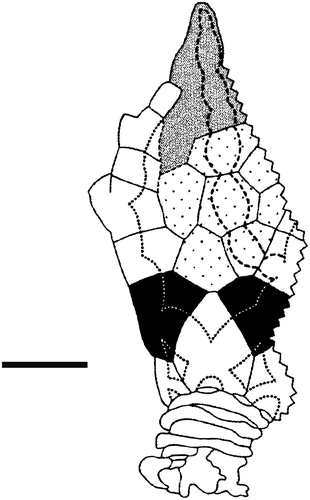
Resolving posterior plate homology between pentacrinoids and camerates
In our current understanding of crinoid phylogeny, the Camerata and Pentacrinoidea are sister clades (Ausich et al. 2015a; Wright et al. 2017). However, reconstruction of the ancestral state of their posterior plating is stifled by morphological ambiguities and phylogenetic uncertainties near the root of the crinoid tree. For example, early Ordovician (Tremadocian) ‘protocrinoid’ taxa such Titanocrinus and Glenocrinus are unusual in having calyces constructed of disorganized plates rather than circlets (Guensburg & Sprinkle 2003). Although both Titanocrinus and Glenocrinus have clearly differentiated posterior interrays, their posterior plate configurations are similarly disorganized, even compared with other early Ordovician crinoids such as Eknomocrinus. Further, the phylogenetic positions of these early occurring taxa are highly uncertain, with studies variously placing them outside of the camerate–pentacrinoid divergence (Guensburg & Sprinkle 2003), sister to pentacrinoids (Ausich et al. 2015a), or sister to camerates (Guensburg 2012, table 1; Cole 2017). Thus, it is uncertain whether protocrinoid taxa represent derived rather than plesiomorphic configurations. Tremadocian crinoids such as Alphacrinus, Apektocrinus, Eknomocrinus and others already have features that phylogenetically link them with clades originating after the camerate–pentacrinoid split (Guensburg & Sprinkle 2009; Guensburg 2010, 2012; Cole 2017, 2018; Wright 2017; Ausich 2018) and comparisons to any currently hypothesized crinoid sister group are equally uninformative (Guensburg et al. 2016; Sheffield & Sumrall 2019).
The question remains: What homology statements can be made between CD-interray plating at the deepest phylogenetic scales, such as between camerates and pentacrinoids? If Amphipsalidocrinus is indeed a neotenic camerate, this unusual crinoid would support the proximal-most posterior plate as homologous across all crinoids and termed the radianal, as argued by Brower (1973, 1975) (acknowledging that some accessory plates may be inserted) (Fig. 3). Although this may well be the case and we are intrigued by many potential links between the primanal in camerates and radianal in pentacrinoids, corroborating evidence in the form of unambiguous ontogenetic data for this interpretation is still required and the issue needs to be more fully explored. Pending further confirmation, we cautiously follow Ubaghs (1978a) and maintain the terminological distinction of the use primanal in camerates and radianal in pentacrinoids. We hope future fossil discoveries will help better clarify posterior plate homologies and patterns of trait evolution in early crinoid lineages (Fig. 2).
Conclusions
We present a re-evaluation of posterior plate homologies in all major crinoid lineages considering evidence from development, fossil ontogenies and phylogenetic relationships. For pentacrinoids, we present a unifying framework for homologizing posterior interray plates among all major lineages. We agree with previous work suggesting that a single posterior plate in cladids is homologous to the radianal and therefore suggest this plate should not be called an anal X in character descriptions. Thus, the proximal-most posterior plate is the radianal, which is followed by the anal X and the right sac plate. Based on its similarity in structure and position relative to the C ray, overall similarity in developmental timing, and close phylogenetic affinities between disparids and cladids, we suggest the single posterior plate in disparids to be homologous with the radianal plate of cladids rather than the anal X. We propose the right sac plate as a replacement name for right tube plate, which is a misnomer because these structures are not likely to be homologous across pentacrinoid and camerate lineages. For camerates, we cautiously retain the term primanal for the proximal-most plate because definitive evidence from early post-larval development is inconclusive regarding posterior plate homology between camerates and pentacrinoids.
Acknowledgements
DFW was supported by a Gerstner Scholar and Lerner–Gray postdoctoral fellowship from the American Museum of Natural History (AMNH). SRC was supported by a Kathryn W. Davis postdoctoral fellowship from the AMNH. We thank B. Deline, S. Thomas and an anonymous reviewer for helpful comments on an earlier draft of this paper.



